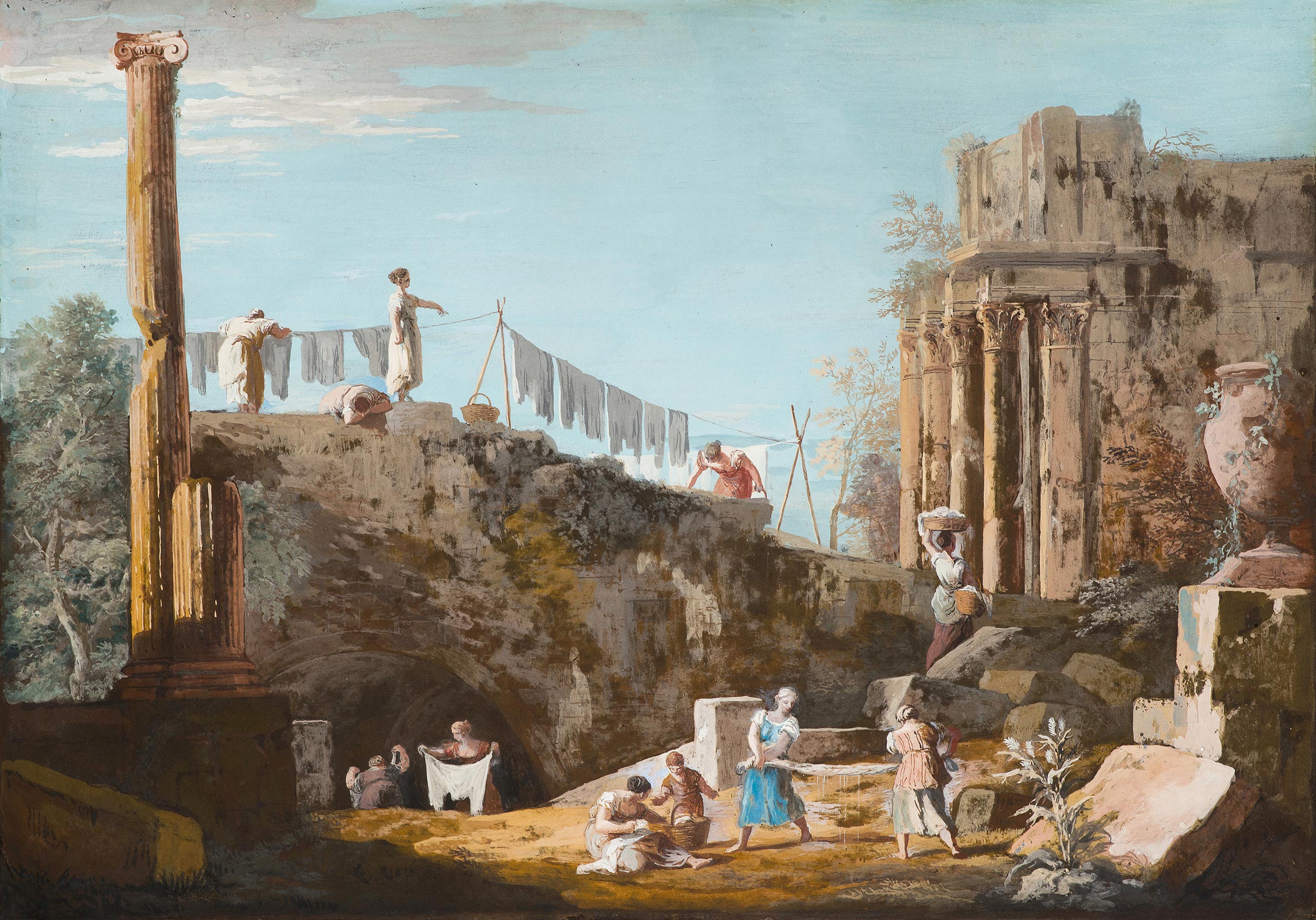
Ricci
Marco
Belluno 1676 — Venice 1730
Washerwomen in a Capriccio Landscape
Tempera on paper laid down on original panel.
316 x 456 mm (12 7/16 x 17 15/16 in.)
It was in the studio of his uncle, the famous Sebastiano Ricci, that Marco began his apprenticeship in the 1690s; he acquired a spectacular skill for painting architecture and landscapes, which would make him one of the most important Vedutist painters of his time.
Involved in a murder case, he spent four years in exile in Split in Dalmatia, where Sebastiano Ricci recommended him to a good local landscape painter. Back in Venice in 1700, he worked as a set painter for the theatre and regularly collaborated with his uncle, thanks to whom he gained access to prestigious commissions such as Ferdinand de Medici. His early works show the influence of Salvator Rosa, Johan Anton Eismann and the Cavalier Tempesta, but above all of Alessandro Magnasco and Antonio Francesco Peruzzini, whose dark tones and luminist effects he adopted. Gradually, his style became more personal, his landscapes brighter and more ethereal, and his figures more important. In 1708, with Gian Antonio Pellegrini, he accompanied Charles Montagu, fourth Earl of Manchester, to London. There, he was immediately employed by the Queen’s Theatre at Haymarket to make opera sets, including those for the prestigious Pirro e Demetrio by Alessandro Scarlatti and Niccòlo Heym. Between 1709 and 1710, he worked with Pellegrini on the decoration of the Earl of Manchester’s residences in London and Kimbolton, as well as Castle Howard. Returning briefly to Venice during the winter of 1711-1712, he set off again for London, this time accompanied by his uncle. Both produced works of exceptional quality for the Duke of Buckingham, Lord Burlington, Richard Boyle and Henry Bentinck (the future Duke of Portland), either alone or as a duo. Finally back in their home town in 1716, Marco and Sebastiano Ricci continued to frequent the English milieu around Consul Joseph Smith, probably their greatest patron, who collected forty-two paintings, one hundred and fifty landscape drawings, theatre designs and caricatures by Marco, which he had engraved in 1743 by Anton Maria Zanetti. Marco was also an engraver, producing etchings of landscapes of which only thirty-three examples are known. His engravings were as crucial as his landscape paintings in the development of this genre in the 18th century, influencing artists such as Canaletto, Michele Marieschi, Francesco Guardi, Giuseppe Zais, Francesco Zuccarelli and Giovanni Battista Piranesi.
About half of Ricci’s oeuvre comprises 150 small landscapes, most of which measure about 30 x 45 cm (12 by 18 inches) painted in tempera, primarily on kidskin – a habit he may have adopted in London – or less frequently, on paper. The bright and luminous colours of these paintings show Ricci’s extraordinary technical skill. He created multiple works of this type on his return to Venice, mostly for foreign visitors.
In these many sunny capricci, in bright and matt colours, the painter accumulates and assemble various architectural motifs taken from Antiquity – columns, arches, porticos and obelisks – with elements of Gothic or modern architecture, as well as natural elements. These works convey the poetic notion of figures wandering in the ruins, archaeologists, philosophers, poets or admirers – sometimes looters – an idea dear to all painters of ruins, from Piranesi to Hubert Robert. The subject here is the pleasant one of washerwomen. They have settled in an ancient site to do the laundry. The wash-house is situated below, under an arch, from which they emerge with the damp clothes and linen. Surrounded by ruins and remains, they wring it out to dry and lay it out on top of a mound, facing the Corinthian columns of an ancient temple. The freshness of the air and the feel of the wind are beautifully rendered in this gouache.
The motif of the temple with columns – here Corinthian – on the right of our work, reappears in other gouaches by the artist, sometimes Doric or Ionic. This is a perfect illustration of the artist’s working method, which involves reusing motifs or parts of motifs that he likes in different compositions, introducing a few variations. It was undoubtedly through his long experience as a decorator in the various theatres of London and Venice that Ricci was able to acquire this art of composition and architectural capriccio, a taste which was to have a great posterity throughout the 18th century.

